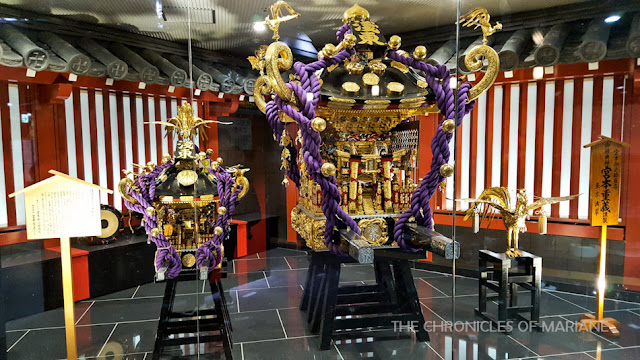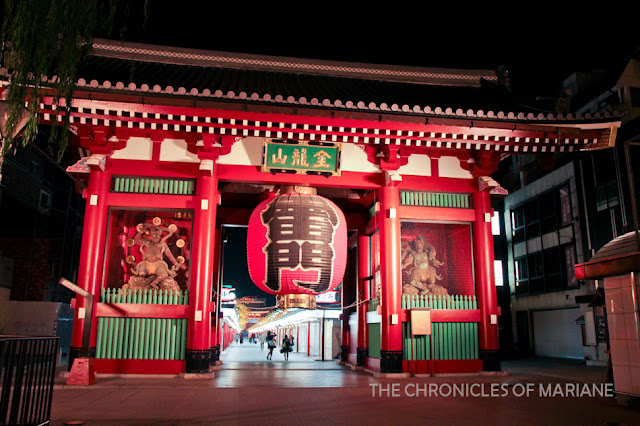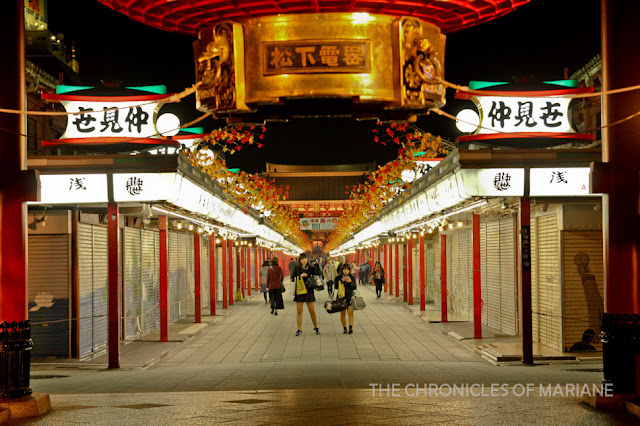There’s definitely more to Tokyo than tall skyscrapers, impressive subways and modern fashion. It’s so easy to be absorbed by all these innovations that one might think it will be difficult to find a slice of traditional Japan in this huge metropolis. Not in Tokyo, though. There are plenty of neighborhoods where you can still observe old traditional sights that most people tend to miss out when they draft their Tokyo itineraries.
 |
| Dempoin Street at night |
First on my agenda is the interesting district of
Asakusa, an area formerly popular for its entertainers (artists, actors and
geishas) from yesteryear. It has retained its unique atmosphere due to the existence of kabuki theaters during the Edo Period. This is also where
Sanja Matsuri, considered to be one of the city’s top three Shinto festivals, is held during May.
It was an interesting, albeit long, subway ride to the Asakusa Station. I tried to navigate without Google Maps and any assistance from Tokyo Metro staff, but I eventually had to give in when I lost an hour or so of my time. I thought I would have already remembered the directions since I had to go to this station which also links the Tobu Railway (which I took to Nikko).
 |
| an interesting display at Asakusa Station |
I was greeted by a sense of nostalgia as I got out of the metro, the area felt familiar, despite this being my first time in Japan (I might have been confused with some scenery from Seoul). It was a weekday noon, but there were still heaps of tourists and rickshaw drivers offering their services everywhere. From a distance, I could clearly see the 634-meter tall
Tokyo Skytree, but I decided to see it for another day, since my focus then was to soak up on the traditional ambiance of Asakusa.
 |
| saw this lovely couple as I exited the station. look at the details of that kimono! |
 |
| Sumida River, a popular area during cherry blossom season. From here, you can also take a river cruise to Hama Rikyu Garden |
Aside from the selfie-sticks, the huge
Kaminarimon (or Thunder Gate in English) is surely impossible to go unnoticed, especially as one enters the historical premises of Asakusa. It was first built 1000 years ago but was unfortunately wrecked due to fire during the 1860s. The current structure was only erected in 1960, and two of its most distinguishable features are the massive statues of Shinto gods Fujin (god of the wind) and Raijin (god of thunder).
 |
| see how the area looks deserted as soon as it gets dark? |
The gate led me to another IG-worthy site called
Nakamise-doori or
Nakamise Shopping Street. This 250-meter stretch is said to be one of the oldest shopping streets in Japan which now still operates selling various goods like snacks, souvenirs, clothing and other memorabilia that you can only buy in the country.
 |
| Stores close as early as 7 until 8pm, but the area still looks interesting with shutter art in almost all the stores |
Sensoji Temple, perhaps one of the most visited temples in all of Japan gathers about 30 million visitors in a year. It is also the oldest marking its completion in 645. As you walk along, you would see Hozomon Gate a five-storey pagoda and the main hall. It doesn’t hurt to follow some etiquette and traditions while you’re in there such as purifying yourself with water before entering the shrine or getting your fortune told by purchasing an
omikuji for 100 yen.
 |
| got a not-so-good forecast in my omikuji :( |
I decided to take a detour and explore the less crowded
Dempoin Street, like Nakamise, it is also filled with stores selling different merchandise, at that time though, most of them were closed for business so it was a great opportunity to see more of Japan's famed shutter art, which are mostly paintings of depicting traditional scenes from daily lives of the Japanese. I noticed this in other areas of Japan as well like Himeji and Kyoto.
 |
| where else can you find such unique art display? |
Unknowingly, I made it to
Rokku Entertainment district which used to be a trendy entertainment area decades ago lined up with cinemas and theaters. When I was there however, there didn’t seem to be any happenings (or it would have been better to go there during the night perhaps?), and it was timely that I chanced upon a Don Quixote branch, my first time to actually see one.

One of my office mates consistently advised me to go to Don Quixote, and from her words, “that place is interesting.” And true enough, I think I may have spent an hour inside this store, half of that was spent looking at the Sweets section cos I love them chocolates. In my experience, pharmacies sell the cheapest chocolates in the country, but they limit the quantity per customer, so if you’re buying in bulk, it’s probably best to do it here. Aside from that, they also sell loads of other stuff here such as clothes, grocery items, electronics, souvenirs and other unique items that you can proudly say are only publicly sold in Japan. I ended my shopping escapade with five small boxes of desserts, ice cream and some cup ramen.
 |
| lots of chocolates... |
 |
| and unique finds (believe me there are LOTS) like this pikachu noodles |
After my visit to some of
Shinjuku’s most visited attractions, I headed to Iidabashi Station to observe a festival called
Kagurazaka O-edo Street Tour, but if not for that, I would have probably not hear about this place. Like Asakusa, it used to be prominent for its geisha houses and
ryotei restaurants (famed for their high-end/luxurious cuisine), similar to what you would see in Gion, Kyoto.
It was intended to be a residence for samurais during the 17th century and now, you can appreciate a beautiful harmony of Japanese and French influence due to the presence of French schools, trendy cafes and bakeries. Another exciting festival held here is the
Kagurazaka Awa odori held every fourth Saturday and Sunday of July, something to look forward during the hot summer in Tokyo.
 |
| views along the Kagurazaka slope |
 |
| I was able to observe the Kagurazaka Oedo Festival which I will be sharing in a separate post :) |
 |
| It is easy to get lost amongst these narrow alleys when your trying to locate a certain restaurant |
One can easily soak in the traditional Japanese atmosphere without going as far as Kyoto, if you are short in time, I definitely recommend adding these places in your schedule. I am also impressed how the locals preserved these districts and hope that our local government in the Philippines, especially in Manila city, follows their example.



























I have never been in a Don Quijote store ever because I am afraid if I go in in the morning, it will be night time when I get out (I am sure there are so many interesting stuff in there)! Anyway, thanks for sharing about this part of Tokyo. Maybe someday I will go back to Tokyo and visit this place. Looking forward to your post about the Kagurazaka Oedo Festival.
ReplyDeleteI suggest setting up an alarm next time (worked for me!) I only had an hour or so but I still have lots of products to try out. Hope next time you could finally check this supermarket out :)
Delete